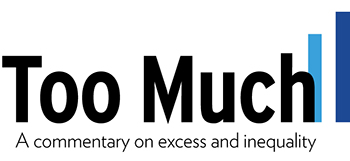The latest round of annual CEO pay reports reveal that corporations are still shelling out big bucks to execs who perform poorly. But that’s not the prime reason CEO pay should have us horrified.
By Sam Pizzigati
Every spring, ever since the mid 1980s, two events annually transpire on the U.S. executive pay front. The first: America’s media biggies release surveys that document the previous year’s prodigious CEO paychecks. The second: Analysts parse these surveys and almost immediately begin bewailing the huge rewards that have gone to CEOs who failed to “perform.”
This spring, so far at least, is going straight to form.
The New York Times, USA Today, the Bloomberg news service, and the Wall Street Journal have, over recent weeks, all reported their CEO pay figures for 2007, and the figures show the same old story. Top executive pay has once again ballooned — up 12 percent, on average, to $12.1 million, says Bloomberg.
These averages still only hint at the vast sums pouring into CEO pace-setter pockets.
Merrill Lynch’s John Thain, the New York Times reports, collected $83.8 million for his labors in 2007. Oracle business software CEO Larry Ellison, adds USA Today, walked off with $61.2 million worth of annual pay. But Ellison also cashed out stock options he had amassed over prior years — and pocketed another $181.8 million in the process.
The latest CEO pay reports have also, once again, prompted still another round of analyst angst over Corporate America’s continuing willingness to pay handsomely, even extravagantly, for poor executive performance.
“True links between pay and performance,” the Times reports, last year “remained scarce,” a reality the paper dubbed the “most irksome” aspect of this year’s CEO pay numbers.
Evidence for that observation abounds. Residential construction giant KB Home, for instance, lost nearly a billion dollars in 2007. But company CEO Jeffrey Mezger somehow merited a $6 million cash bonus.
Or how about Home Depot, where net income fell 23 percent in 2007 and compensation for the company’s CEO, Steve Odland, rose 85 percent — to $18 million. And don’t forget Sprint Nextel CEO Gary Forsee. He retired under pressure at year’s end, but not before garnering almost $40 million in annual remuneration. He’s now collecting a $84,325 monthly pension.
Isolated cases? Hardly. The CEOs of the nation’s 10 largest financial services companies, notes the Times, collected $320 million in pay last year. The companies they led wrote off an astounding $55 billion in mortgage losses.
In response to all this, commentators and reformers in the institutional investor community are demanding, for the umpteenth year in a row, that corporate boards do more to hold their top execs to the pay-for-performance fire.
“We’re not against pay,” declares Dennis Johnson, a heavyweight with Calpers, the powerful California pension fund. “But we are certainly against pay for failure, or for just showing up.”
Corporate board members, for their part, are vowing to clamp down.
“We get the message,” the top gun at the trade journal for corporate directors, Jeff Cunningham, told USA Today. “Directors are at the negotiating table with their CEOs, looking for very rational pay schemes; no funny business, no games — just pure performance-driven pay planning.”
In other words, next year nothing will change — because the annual hand-wringing over “pay for performance” obscures the real paycheck rot in Corporate America. Making sure that top execs only get paid for “performing” won’t end that root rot. We face a much bigger challenge: making sure that corporate paychecks recognize the contributions of all “performers.”
Corporations today seldom do that. Instead they recognize — and reward — only the executive suite contribution to corporate achievement. In 2007, U.S. worker average weekly wages increased by 3.6 percent. Average CEO take-homes, not counting stock-option cash-outs, soared over three times faster.
Reformers and commentators who insist on “pay for performance” at the executive level tend not to angst about this discrepancy. Indeed, many reformers operate from the same assumption that guides corporate boards. They credit corporate success to executive success. They would consider a 10 percent CEO pay hike a fitting “pay for performance” reward at a company where shareholders saw a 10 percent on their investment — even if workers at that same enterprise received no pay increase at all.
In Corporate America’s current compensation calculus, in effect, only CEOs count. These CEOs need not prove that their personal labors have contributed more to corporate success than anyone else’s labors. If things go well, these top executives simply get all the credit — and all the big bucks.
And if things go poorly? In that case, top executives only get the big bucks.
Sam Pizzigati edits Too Much, the online weekly on excess and inequality published by the Washington, D.C.-based Institute for Policy Studies.



Discussion
No comments for “Corporate America’s Pay-for-Performance Charade”